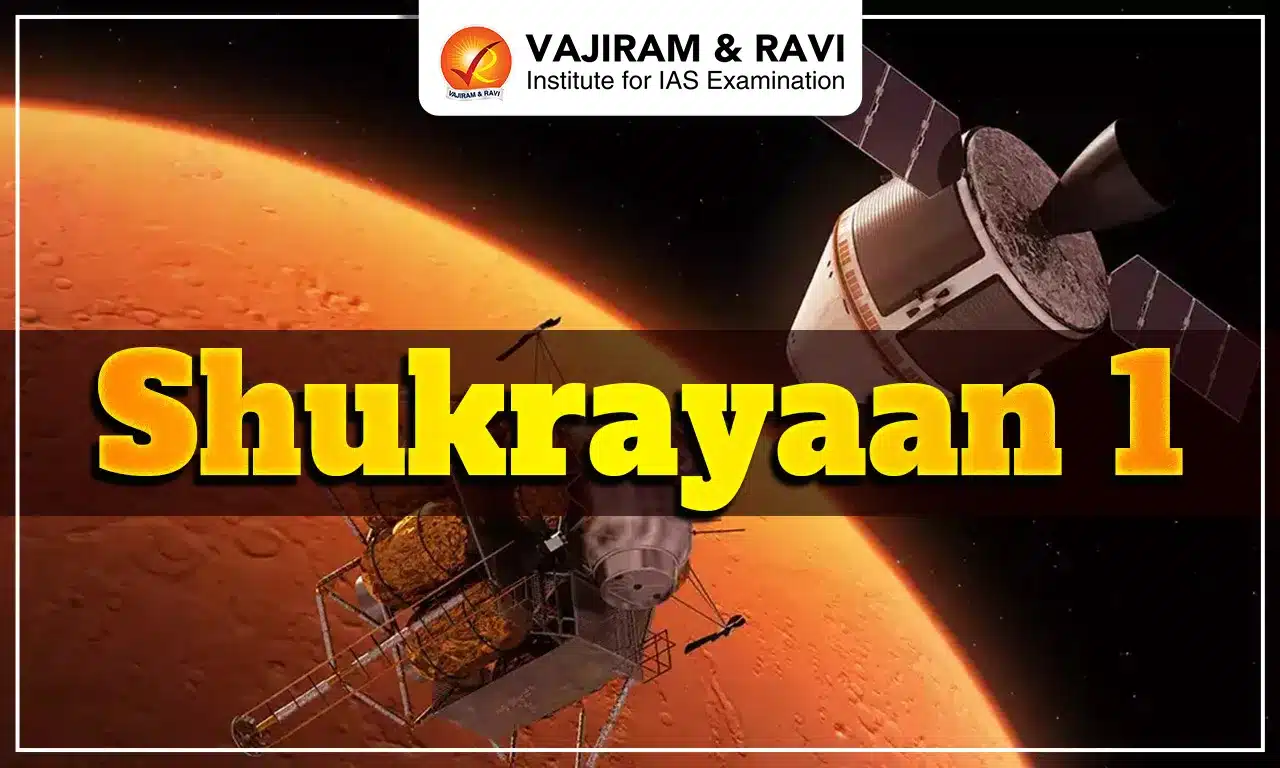Shukrayaan 1, also known as the Venus Orbiter Mission, is ISRO's planned first mission to the planet Venus. It involves a spacecraft of 2500 kg orbiting Venus to study what lies beneath the surface of the hottest planet in the solar system as well as the mysteries beneath its sulfuric acid clouds. The Shukrayaan Mission will be carried out by a GSLV Mk II rocket, with the scientific payloads of a high-resolution synthetic aperture radar and a ground-penetrating radar.
Objectives of the Shukrayaan 1
The Shukrayaan mission's primary goal is to conduct a comprehensive study of Venus, also known as "Earth's twin."
- To Examine Venus's surface and atmosphere: Venus has a dense atmosphere that obscures its surface, which makes it difficult to study.
- The goal of Shukrayaan-1 is to penetrate through this layer and reveal the secrets below, which will allow a greater understanding of weathering, erosion, and other geological phenomena.
- To Analyse geological composition: The geological composition of Venus is not much studied, and its surface is covered with poisonous clouds.
- The mission will provide vital information for understanding the planet's geological history.
- To examine the relationship between solar radiation and surface particles: Scientists are eager to investigate the interaction between solar radiation and surface features on Venus, which could shed light on planetary evolution.
Significance of the Shukrayaan 1
Shukrayaan-1 is extremely significant not only for India but also for the global scientific community.
- Studying Venus: India's Venus mission will provide scientists and the space community with a glimpse into the planet's future, as Earth was also not habitable billions of years ago.
- It will also help to understand the link between solar radiation and the surface particles on Venus.
- While life on Venus's scorching surface is currently thought to be unlikely, recent discoveries have raised intriguing possibilities.
- Microbial life on Venus: Scientists have discovered phosphine in Venus' clouds, which could be an indicator of microbial life in the planet's cooler, higher-altitude regions.
- This discovery has sparked hope and people's curiosity about the possibility of life beyond Earth.
Challenges for the Shukrayaan 1
Landing on the surface of Venus can be a difficult task. The difficulties in landing on Venus are enormous due to its extremely hostile environment. To date, the longest time any spacecraft has spent on the surface is slightly more than two hours, set by the Soviet Union's Venera 13 probe in 1981.
- Extreme Temperature: The average surface temperature of Venus is more than 460°C, which can easily damage or destroy spacecraft components.
- Crushing Atmospheric Pressure: The atmospheric pressure on Venus's surface is 90 times greater than on Earth.
- This can be extremely challenging for any lander or rover to withstand such high pressures.
- Corrosive Sulfuric Acid Rain: Sulfuric acid clouds dominate much of the upper atmosphere above Venus' surface.
- These clouds cause intense sulfuric acid rainfalls that can corrode most materials including spacecraft components made from titanium and stainless steel.
- Power Systems: There is a lack of sunlight (due to dense clouds) on Venus that can be used by solar panels.
- Alternative power systems, such as radioisotope thermoelectric generators (RTGs), have been successfully used in missions by other countries, but they present their challenges in terms of safety and reliability.
- Communication: The thick atmosphere of Venus obstructs communication with mission control on Earth.
- The planet's highly reflective clouds also cause signal attenuation, making radio communications difficult for spacecraft.
Other Global Missions to Venus
Despite the significant technical challenges of landing on Venus, several pioneering missions to explore this planet have been launched.
- Venera Series (1961-1984): With its Venera series, the Soviet Union was the first to send spacecraft to Venus. They launched several successful missions between 1961 and 1984, including flybys, orbiters, landers, and balloons.
- Pioneer Venus (1978): The United States sent its first mission to Venus in 1978 consisting of both an orbiter and a multiprobe that studied various aspects of the planet including atmospheric composition and temperature, cloud structure and dynamics, and surface features using radar mapping.
- Magellan (1989): It was launched by NASA in 1989 and used radar imaging to map the entire surface of Venus.
- Magellan made hundreds of passes over the planet over the course of four years, gathering detailed topographic information about its geology.
- Akatsuki (2010): It is an orbiter launched by Japan's space agency JAXA in 2010 to study Venus' atmospheric circulation patterns using infrared cameras.
- Future Missions: Several countries have future missions planned to further explore this hostile planet.
- VERITAS: NASA's next mission is set to launch in 2026. This mission will use radar imaging to map the surface of Venus and study its geology.
- DAVINCI: NASA mission expected by 2026 aims to study Venus' atmosphere using a descent sphere.
- EnVision: Europe's space agency ESA is expected to launch it in the 2030s. This orbiter will use radar imaging to create high-resolution maps of Venus' surface features and provide insights into the planet's geology.
Last updated on November, 2025
→ Check out the latest UPSC Syllabus 2026 here.
→ Join Vajiram & Ravi’s Interview Guidance Programme for expert help to crack your final UPSC stage.
→ UPSC Mains Result 2025 is now out.
→ UPSC Notification 2026 is scheduled to be released on January 14, 2026.
→ UPSC Calendar 2026 is released on 15th May, 2025.
→ The UPSC Vacancy 2025 were released 1129, out of which 979 were for UPSC CSE and remaining 150 are for UPSC IFoS.
→ UPSC Prelims 2026 will be conducted on 24th May, 2026 & UPSC Mains 2026 will be conducted on 21st August 2026.
→ The UPSC Selection Process is of 3 stages-Prelims, Mains and Interview.
→ UPSC Result 2024 is released with latest UPSC Marksheet 2024. Check Now!
→ UPSC Prelims Result 2025 is out now for the CSE held on 25 May 2025.
→ UPSC Toppers List 2024 is released now. Shakti Dubey is UPSC AIR 1 2024 Topper.
→ UPSC Prelims Question Paper 2025 and Unofficial Prelims Answer Key 2025 are available now.
→ UPSC Mains Question Paper 2025 is out for Essay, GS 1, 2, 3 & GS 4.
→ UPSC Mains Indian Language Question Paper 2025 is now out.
→ UPSC Mains Optional Question Paper 2025 is now out.
→ Also check Best IAS Coaching in Delhi
Tags: quest shukrayaan 1

















